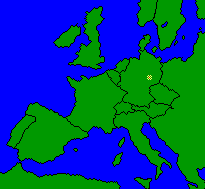Introduction
The organ in the Cathedral of Merseburg was built by Friedrich Ladegast and completed in 1855. Ladegast was in the forefront of German organ builders in the middle of the century. His larger instruments use Barker machines, a technology he learned from Cavaillé-Coll while visiting Paris. His instruments have the full, round sound one would expect to hear in a Romantic instrument, even one by Cavaillé-Coll. In spite of the tonal and mechanical similarities, however, Ladegast's instruments are decidedly German, not French in their stoplists.199 He typically included a far greater range of flues and relatively few reeds compared to French instruments of the period.
This particular instrument has an important place in the history of German Romantic organ music. Liszt's Prelude and Fugue on B-A-C-H was written for its inauguration, but the piece was not completed in time for the performance. The organist was one of Liszt's students, Alexander Winterberger, who substituted Liszt's Fantasia and Fugue on the Choral "Ad nos, ad salutarem undam". Another of Liszt's students, Julius Reubke, premiered his own Sonata on the 94th Psalm in a recital on this organ in 1857. This instrument, then, is tied to three of the largest, most dramatic nineteenth-century German works for organ.
Hauptwerk (II)
C-g''' |
|
Oberwerk (III)
C-g''' |
|
Brustwerk (IV)
C-g''' |
|
| Bordun (TC) |
|
32 |
|
Quintatön |
|
16 |
|
Lieblichgedeckt |
|
16 |
|
| Principal |
|
16 |
|
Principal |
|
8 |
|
Geigenprincipal |
|
8 |
|
| Bordun |
|
16 |
|
Rohrflöte |
|
8 |
|
Lieblichgedeckt |
|
8 |
|
| Principal |
|
8 |
|
Gambe |
|
8 |
|
Flauto dolce |
|
8 |
|
| Hohlflöte |
|
8 |
|
Flauto amabile |
|
8 |
|
Salicional |
|
8 |
|
| Doppelflöte |
|
8 |
|
Gedeckt |
|
8 |
|
Unda maris II |
|
8 |
|
| Gemshorn |
|
8 |
|
Oktave |
|
4 |
|
Oktave |
|
4 |
|
| Gambe |
|
8 |
|
Spitzflöte |
|
4 |
|
Zartflöte |
|
4 |
|
| Quinte |
|
5 1/3 |
|
Rohrflöte |
|
4 |
|
Salicional |
|
4 |
|
| Oktave |
|
4 |
|
Quinte |
|
2 2/3 |
|
Nassat |
|
2 2/3 |
|
| Spitzflöte |
|
4 |
|
Waldflöte |
|
2 |
|
Oktave |
|
2 |
|
| Gedackt |
|
4 |
|
Terz |
|
1 3/5 |
|
Cimbel III |
|
|
|
| Doublette II |
|
4+2 |
|
Sifflöte |
|
1 |
|
Progressiveharmonica II-IV |
|
|
|
| Quinte |
|
2 2/3 |
|
Mixtur IV |
|
|
|
Aeoline |
|
16 |
|
| Oktave |
|
2 |
|
Schalmei |
|
8 |
|
| Mixtur IV |
|
|
|
Stahlspiel |
|
| Scharff IV |
|
|
|
| Cornett III-V |
|
|
|
| Fagott |
|
16 |
|
| Trompete |
|
8 |
|
Rückpositiv (I)
C-g''' |
|
Pedal
C-f' |
|
Pedal
(Continued) |
| Bordun |
|
16 |
|
Untersatz |
|
32 |
|
Oktave |
|
4 |
|
| Principal |
|
8 |
|
Principal |
|
16 |
|
Flöte |
|
4 |
|
| Flauto traverso |
|
8 |
|
Salicetbass |
|
16 |
|
Scharfflöte |
|
4 |
|
| Fugara |
|
8 |
|
Violonbass |
|
16 |
|
Mixtur IV |
|
|
|
| Quintatön |
|
8 |
|
Subbass |
|
16 |
|
Cornett IV |
|
|
|
| Octave |
|
4 |
|
Grossnassat |
|
10 2/3 |
|
Posaune |
|
32 |
|
| Gedeckt |
|
4 |
|
Principal |
|
8 |
|
Posaune |
|
16 |
|
| Octave |
|
2 |
|
Violoncello |
|
8 |
|
Dulcian |
|
16 |
|
| Mixtur IV |
|
|
|
Bassflöte |
|
8 |
|
Trompete |
|
8 |
|
| Cornet II-V |
|
|
|
Terz |
|
6 2/5 |
|
| Oboe |
|
8 |
|
Rohrquint |
|
5 1/3 |
|
| |
| Couplers: |
OW-HW
RP-HW
BW-HW
HW-Pedal
OW-Pedal
RP-Pedal |
Mechanical key action
Barker level pneumatic assist
Mechanical stop action
|
|

